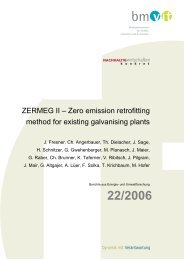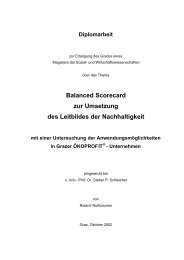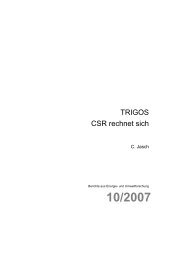Promoting Resource Efficiency in Small & Medium size ... - UNEP
Promoting Resource Efficiency in Small & Medium size ... - UNEP
Promoting Resource Efficiency in Small & Medium size ... - UNEP
Create successful ePaper yourself
Turn your PDF publications into a flip-book with our unique Google optimized e-Paper software.
• Chemical stability<br />
• Compatibility<br />
• Miscibility with lubricat<strong>in</strong>g oils<br />
• Dielectric strength<br />
• Ease of leak detection<br />
Prior to the environmental issues of ozone layer depletion and global<br />
warm<strong>in</strong>g, the most widely used refrigerants were: R 11, R 12, R 22, R<br />
502 and ammonia. Of these, R 11 was primarily used with centrifugal<br />
compressors <strong>in</strong> air-condition<strong>in</strong>g applications. R 12 was used primarily <strong>in</strong><br />
small capacity refrigeration and cold-storage applications, while the other<br />
refrigerants were used <strong>in</strong> large systems such as large air-condition<strong>in</strong>g<br />
plants or cold storages. Among the refrigerants used, except ammonia,<br />
all the other refrigerants are synthetic refrigerants and are non-toxic and<br />
non-flammable. Although ammonia is toxic, it has been very widely used<br />
due to its excellent thermodynamic and thermo physical properties.<br />
S<strong>in</strong>ce ozone layer depletion could lead to catastrophe on a global level,<br />
it has been agreed by the global community to phase out the ozone<br />
deplet<strong>in</strong>g substances (ODS). As a result, except for ammonia, all the other<br />
refrigerants used <strong>in</strong> cold storages had to be phased-out and a search<br />
for suitable replacements began <strong>in</strong> earnest. In view of the environmental<br />
problems caused by the synthetic refrigerants, options differed on<br />
replacements for conventional refrigerants. The alternate refrigerants can<br />
be classified <strong>in</strong>to two broad groups:<br />
• Non-ODS, synthetic refrigerants based on Hydrofluorocarbons<br />
(HFCs) and their blends<br />
• Natural refrigerants <strong>in</strong>clud<strong>in</strong>g ammonia, carbon dioxide,<br />
hydrocarbons and their blends<br />
The potential for a s<strong>in</strong>gle molecule of the refrigerant to destroy the<br />
Ozone Layer is called ODP - The ODP or Ozone Depletion Potential. All<br />
refrigerants use R11 as a datum reference where R11 has an ODP = 1.0.<br />
The lower the value of the ODP - the better the refrigerant is for the ozone<br />
layer and the environment.<br />
Examples:<br />
Refrigerant R11:<br />
R11 is a s<strong>in</strong>gle chlorofluorocarbon or CFC compound. High chlor<strong>in</strong>e<br />
content and Ozone Depletion Potential (ODP1) = 1. High Global Warm<strong>in</strong>g<br />
Potential (GWP2) = 4000. The use and manufacture of R11 and similar<br />
CFC refrigerants is now banned with<strong>in</strong> the European Union even for<br />
servic<strong>in</strong>g. Non flammable, non corrosive non toxic, stable. 80<br />
Refrigerant R12:<br />
Difluorodichloromethane is related to the CFC group. It is characterised<br />
by high ozone depletion potential (ODP = 1) and big global warm<strong>in</strong>g<br />
potential (GWP = 8500). Clear gas with specific smell, 4.18 times as heavy<br />
as the air. One of the most widespread and safe <strong>in</strong> operation refrigerants. 81<br />
The effect of ammonia 82<br />
Ammonia can safely be used as a refrigerant provided the system is properly<br />
designed, constructed, operated and ma<strong>in</strong>ta<strong>in</strong>ed. Ammonia however is toxic<br />
and can be a hazard to human health. The Occupational Safety and Health<br />
Adm<strong>in</strong>istration (OSHA) Permissible Exposure Level (PEL) is 50 parts per<br />
million (ppm), 8-hour time-weighted average. Although pure ammonia<br />
vapours are not flammable at concentrations of less than 16%, they may<br />
be a fire and explosion hazard at concentrations between 16 and 25%.<br />
Mixtures <strong>in</strong>volv<strong>in</strong>g ammonia contam<strong>in</strong>ated with lubricat<strong>in</strong>g oil from the<br />
system, however, may have a much broader explosive range. An important<br />
property of ammonia is its pungent odour. The threshold concentration<br />
at which ammonia is detectable varies from person to person; however,<br />
ammonia can be detected usually at concentrations <strong>in</strong> the range of 5 ppm<br />
to 50 ppm. Concentrations above 100 ppm are uncomfortable for most<br />
people.<br />
The effect of Volatile Organic Compounds (VOC)<br />
Volatile organic compounds are compounds that have a high vapour<br />
pressure and low water solubility. Many VOCs are human-made<br />
chemicals that are used and produced <strong>in</strong> the manufacture of pa<strong>in</strong>ts,<br />
pharmaceuticals and refrigerants. VOCs typically are <strong>in</strong>dustrial solvents,<br />
such as trichloroethylene; fuel oxygenates, such as methyl tert-butyl ether<br />
(MTBE); or byproducts produced by chlor<strong>in</strong>ation <strong>in</strong> water treatment, such<br />
as chloroform. VOCs are often components of petroleum fuels, hydraulic<br />
fluids, pa<strong>in</strong>t th<strong>in</strong>ners and dry clean<strong>in</strong>g agents. VOCs are common groundwater<br />
contam<strong>in</strong>ants. 83<br />
VOCs <strong>in</strong>clude a variety of chemicals, some of which may have<br />
short- and long-term adverse health effects. Concentrations of<br />
many VOCs are consistently higher <strong>in</strong>doors (up to ten times higher)<br />
than outdoors. VOCs are emitted by a wide array of products<br />
number<strong>in</strong>g <strong>in</strong> the thousands. Examples <strong>in</strong>clude: pa<strong>in</strong>ts and<br />
lacquers, pa<strong>in</strong>t strippers, clean<strong>in</strong>g supplies, pesticides, build<strong>in</strong>g<br />
materials and furnish<strong>in</strong>gs, office equipment such as copiers and<br />
pr<strong>in</strong>ters, correction fluids and carbonless copy paper, graphics and<br />
craft materials <strong>in</strong>clud<strong>in</strong>g glues and adhesives, permanent markers<br />
and photographic solutions.<br />
Organic chemicals are widely used as <strong>in</strong>gredients <strong>in</strong> household products.<br />
Pa<strong>in</strong>ts, varnishes and wax all conta<strong>in</strong> organic solvents, as do many<br />
clean<strong>in</strong>g, dis<strong>in</strong>fect<strong>in</strong>g, cosmetic, degreas<strong>in</strong>g and hobby products. Fuels<br />
are made up of organic chemicals. All of these products can release<br />
organic compounds while you are us<strong>in</strong>g them and, to some degree, when<br />
they are stored. 84<br />
The ability of organic chemicals to cause health effects varies greatly<br />
from those that are highly toxic, to those with no known health effect.<br />
As with other pollutants, the extent and nature of the health effect will<br />
depend on many factors <strong>in</strong>clud<strong>in</strong>g level of exposure and length of time<br />
exposed. Eye and respiratory tract irritation, headaches, dizz<strong>in</strong>ess,<br />
visual disorders and memory impairment are among the immediate<br />
symptoms that some people have experienced soon after exposure to<br />
some organic chemicals. At present, not much is known about what<br />
health effects occur from the levels of organic chemicals usually found<br />
<strong>in</strong> homes. Many organic compounds are known to cause cancer <strong>in</strong><br />
animals; some are suspected of caus<strong>in</strong>g, or are known to cause, cancer<br />
<strong>in</strong> humans. 85<br />
80) The Energeer<strong>in</strong>g ToolBox, Refrigerants – Environmental Properties, undated<br />
81) NBCC, Traditional Refrigerants, undated<br />
82) EPA, Hazards of Ammonia Releases at Ammonia Refrigeration Facilities (Update), 2001<br />
83) U.S.G.S., Volatile Organic Compounds (VOCs), undated<br />
84) EPA – Environmental Protection Agency, An Introduction to Indoor Air Quality, undated<br />
85) EPA – Environmental Protection Agency, An Introduction to Indoor Air Quality, undated<br />
76
















